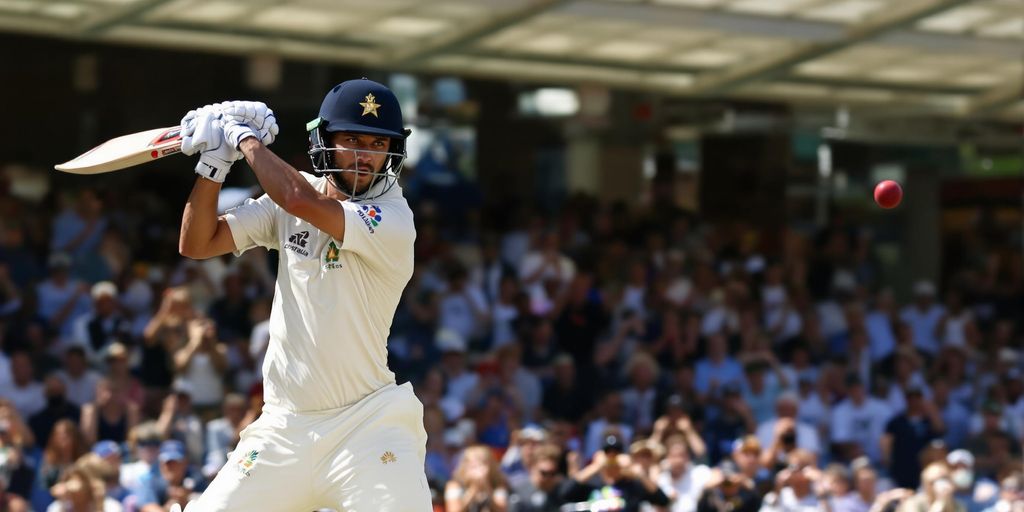Understanding Australian Test Cricket Batting Averages

Definition of Batting Average
Okay, so what is a batting average? Basically, it’s a way to see how many runs a batter scores for each time they get out. You calculate it by dividing the total number of runs a batter has scored by the number of times they’ve been dismissed. It’s a pretty simple calculation, but it gives you a good idea of how consistent a batter is. For example, if a player has scored 5000 runs and been out 100 times, their average is 50.00. Easy peasy.
Importance in Player Evaluation
Batting average is a big deal when it comes to judging how good a cricketer is. It’s not the only thing that matters, of course, but it’s a key stat. A high average usually means a batter is reliable and can consistently score runs. Coaches, selectors, and even fans use it to compare players and decide who’s performing well. It helps answer the big questions:
- Is this bloke worth keeping in the team?
- Are they pulling their weight?
- How do they stack up against other legends?
It’s important to remember that batting average doesn’t tell the whole story. Things like the difficulty of the pitches they played on, the quality of the opposition’s bowling attack, and even luck can all play a part. But still, it’s a pretty handy number to have.
Comparison with Other Formats
Test cricket is a different beast compared to other forms of the game, like One Day Internationals (ODIs) or Twenty20 (T20). In Tests, batters have to be more patient and build long innings. This usually means batting averages in Test cricket are lower than in ODIs or T20s, where scoring quickly is the main goal. A good Test average is generally considered to be 40 or above, while in ODIs, you might see players averaging 50 or even 60. The context is everything, really. Here’s a quick comparison:
| Format | Typical Batting Average | Key Characteristics |
|---|---|---|
| Test Cricket | 30-50 | Patience, endurance, technique |
| ODI Cricket | 30-60 | Aggression, adaptability |
| T20 Cricket | 20-40 | Power hitting, innovation |
Historical Trends in Batting Averages
Evolution Over the Decades
Right, so let’s have a yarn about how batting averages have changed over time. It’s not just a simple case of things getting better; there are ups and downs, depending on the era. Back in the day, pitches were uncovered, meaning they could be absolute greentops or dustbowls, making life tough for batsmen. Now, with covered pitches and better gear, you’d expect averages to be sky-high, but it’s not always the case. Think about the Bodyline series – that wasn’t exactly conducive to big scores, was it?
Impact of Different Eras
Different eras bring different challenges. The Bradman era was just something else, wasn’t it? His average is off the charts. Then you had the 70s and 80s with Lillee and Thomson terrorising batsmen – pace was king. Now, it’s more about all-round skills and adapting to different conditions. You see more emphasis on scoring quickly, which can affect averages. The pitches are better now, but the pressure is on to keep the scoreboard ticking over.
Notable Changes in Playing Conditions
Playing conditions have changed heaps over the years, and it’s had a big impact on batting averages. Used to be, uncovered pitches meant you were facing a different beast every innings. Now, pitch preparation is a science, and we’ve got sightscreens that actually work. The bats are better, the protective gear is top-notch, and the outfields are lightning fast. All this means batsmen can score more freely, but then again, bowlers have gotten smarter too. It’s a constant game of catches/stumpings.
The introduction of helmets and other protective gear has definitely allowed batsmen to take more risks. Back in the day, facing express pace without a helmet was a different ball game altogether. Now, batsmen can be a bit more fearless, which can lead to higher scores, but also more dismissals.
Here’s a quick look at how things have changed:
- Pitch Conditions: From uncovered greentops to prepared surfaces.
- Equipment: From basic bats to high-tech willow and protective gear.
- Rules: Changes in LBW laws and field restrictions.
Top Australian Test Batsmen by Average
It’s always a good yarn discussing who the best batsmen are, and batting average is a key stat we often look at. It gives a fair indication of a player’s consistency and ability to score runs, which, let’s be honest, is the main job of a batsman. But it’s not the only thing that matters, of course. Context is everything, as they say.
Legends of the Game
When you think of Australian batting legends, a few names immediately spring to mind. Don Bradman, of course, is in a league of his own. His average is just ridiculous, and it’s unlikely anyone will ever get close. Then you’ve got blokes like Steve Smith, Ricky Ponting, and Greg Chappell, all with impressive averages that put them among the best in the world. These guys didn’t just score runs; they dominated attacks and won matches for Australia.
Current Stars
Looking at the current crop, there are some seriously talented batsmen. Marnus Labuschagne has been a run-scoring machine since he came into the side, and his average reflects that. Steve Smith is still going strong, too. It’s exciting to see these guys performing at the highest level and carrying on the tradition of Australian batting excellence.
Emerging Talents
It’s always exciting to see young players coming through the ranks and showing promise. There are a few young batsmen who have the potential to become future stars. It’s still early days, but if they can maintain their form and continue to develop, they could be the next big thing in Australian cricket. We’ll be watching their averages closely to see how they progress.
It’s important to remember that batting average is just one piece of the puzzle. Things like strike rate, performance in crucial matches, and the ability to handle pressure are also important factors to consider when evaluating a player’s overall contribution to the team. It’s all part of the mix, really.
Factors Influencing Batting Averages

Pitch Conditions
Mate, you can’t talk about batting averages without mentioning the pitch. A green top will have the quicks licking their lips, while a dust bowl is a spinner’s paradise. Think about it: a batsman facing Mitchell Starc on a bouncy Perth wicket is going to have a tougher time than facing a part-timer on a flat track in Adelaide. The variability in pitch conditions across different grounds and even different days at the same ground has a massive impact. It’s not just about the average bounce and seam movement either; things like moisture content and the amount of sunlight can change the pitch dramatically over the course of a match.
Opposition Quality
Who you’re playing against makes a huge difference, obviously. Facing a world-class bowling attack like the South Africans with Steyn and Philander in their prime is a different kettle of fish compared to taking on a weaker team. Some blokes just seem to struggle against certain bowlers or types of bowling. For example, a batsman might be great against pace but struggle against quality spin. The Australian cricket team schedule can be brutal, throwing you into the deep end against top-tier teams one after another.
Player Fitness and Form
Fitness and form are crucial. A bloke carrying an injury or going through a rough patch is less likely to score big runs. Cricket is as much a mental game as it is physical, and if a player’s head isn’t in the right place, their average will suffer. Think about the mental fatigue of constant touring, the pressure of expectations, and the impact of personal issues. It all adds up.
Here’s a few things that can affect a player’s form:
- Lack of sleep
- Poor diet
- Personal issues
- Over training
Averages don’t tell the whole story. You’ve got to consider the context. Was the bloke injured? Was he playing on a road or a minefield? Who was he up against? All these things matter when you’re judging a player’s true ability.
Batting Averages in Iconic Series
The Ashes
The Ashes. Just the name conjures up images of tense battles and legendary performances. Batting averages in the Ashes are often scrutinised more than any other series, and for good reason. It’s the ultimate test of a player’s mettle. The pressure, the history, the sheer intensity of the contest – it all impacts how a batsman performs. You can see careers defined, or broken, in this series. The conditions in England and Australia are so different, and that adds another layer of complexity. Some players thrive, others crumble. It’s fascinating to watch.
Border-Gavaskar Trophy
The Border-Gavaskar Trophy, contested between Australia and India, has become a modern-day classic. The spin-friendly pitches of India present a unique challenge for Aussie batsmen, and vice versa. The stats often tell a story of contrasting fortunes, with home advantage playing a significant role. The series has produced some incredible batting performances over the years, and the averages reflect the skill and determination required to succeed in these conditions. The highest career batting averages are a testament to this.
World Test Championship
The World Test Championship (WTC) is relatively new, but it’s already adding another dimension to Test cricket. Batting averages in WTC matches now carry extra weight, as they contribute to a team’s overall standing. It’s interesting to see how players adapt their approach, knowing that every run counts towards the bigger goal of reaching the WTC final. The pressure is on, and the averages will be closely monitored to see who can perform consistently under this new format.
The WTC has changed the landscape. It’s not just about winning individual series anymore; it’s about accumulating points consistently over a two-year cycle. This puts a premium on consistent batting performances, and the averages will be a key indicator of who is stepping up to the challenge.
Here’s a quick look at some hypothetical batting stats in a recent WTC cycle:
- Player A: Average of 45.20 across 10 matches
- Player B: Average of 38.50 across 12 matches
- Player C: Average of 51.00 across 8 matches
Statistical Analysis of Batting Performance
Runs Scored vs. Innings Played
Looking at runs scored against innings played gives you a basic idea, but it’s not the whole story. A bloke might score a heap of runs, but if he’s played a mountain of innings, his average might not be as flash as someone who scores fewer runs in fewer innings. It’s all about efficiency, really. You want someone who makes the most of their opportunities at the crease.
Centuries and Fifties
Centuries are gold, right? They show a player can not only get a start but also convert it into a big score. Fifties are handy, but they don’t win you games like tonnes do. The ratio of centuries to fifties can tell you a bit about a batsman’s temperament and ability to go on with it. Some players are happy with a fifty, while others are hungry for three figures.
Strike Rates and Their Relevance
Strike rates in Test cricket? It’s a bit of a debate. Traditionally, it wasn’t as important as it is now. Back in the day, grinding out runs was the name of the game. But these days, with more aggressive batting styles and the rise of T20 cricket, a decent strike rate can put pressure back on the bowlers and change the momentum of a match. It’s not just about survival; it’s about scoring quickly when the opportunity arises.
It’s important to remember that stats don’t tell the whole story. You’ve got to consider the context of the game, the conditions, and the opposition. Averages are a good starting point, but they’re just one piece of the puzzle.
Comparative Analysis with Other Nations
Australia vs. England
When you think about cricket rivalries, Australia versus England – The Ashes – is right up there. It’s not just about winning; it’s about bragging rights. Looking at batting averages, it’s interesting to see how Aussie batsmen stack up against their English counterparts over the years. Historically, Australia has often boasted higher batting averages, reflecting their dominant periods in the game. But England has had their fair share of batting legends too, making for some fascinating comparisons.
Australia vs. India
Australia and India have had some cracking contests, especially in recent times. The Border-Gavaskar Trophy is always a tough one, with pitches playing a big role. Indian batsmen, known for their skill against spin, often thrive at home, while Aussie batsmen sometimes struggle to adapt. It’s a real test of skill and temperament. The averages can tell a story of home ground advantage and how players adapt to different conditions. Here’s a quick look at how some of the greats compare:
| Player | Country | Career Average |
|---|---|---|
| Ricky Ponting | Australia | 51.85 |
| Sachin Tendulkar | India | 53.78 |
| Steve Smith | Australia | 58.62 |
| Virat Kohli | India | 49.29 |
Australia vs. South Africa
Australia and South Africa have a history of hard-fought battles. Both teams are known for their pace attacks, which can make life difficult for batsmen. South African pitches can be quite bouncy, testing the technique of batsmen from both sides. The head-to-head batting averages often reflect the quality of the bowling attacks and the ability of batsmen to handle pace and bounce. It’s always a good series to watch if you like seeing batsmen put under pressure.
Comparing batting averages across different nations isn’t just about numbers. It’s about understanding the conditions, the opposition, and the eras in which these players played. It gives you a better picture of their achievements and how they stack up against the best in the world.
The Role of Batting Averages in Team Selection
Selection Criteria
Batting averages are, without a doubt, a key part of picking the Aussie Test side. But it’s not as simple as just picking the blokes with the highest numbers. Selectors look at a range of things. A player’s average gives an indication of their consistency and ability to score runs, but it’s viewed alongside other stats and observations.
- Recent form is crucial. A player with a good average might be struggling lately, and someone else might be in red-hot form.
- The conditions of the upcoming series matter. Is it a tour of India where spin dominates, or a home summer on bouncy pitches? This influences the type of batsmen needed.
- The balance of the team is also considered. Do we need a solid opener, a dynamic middle-order player, or someone who can bowl a bit too?
Impact on Team Strategy
How the batting lineup is structured has a big impact on the team’s overall strategy. A team with a lot of high-average batsmen can afford to be more aggressive, knowing they have the firepower to recover from setbacks. Conversely, a team with a weaker batting lineup might need to be more conservative, focusing on grinding out runs and minimising risks. The batting average of a player can influence their position in the batting order. For example, someone with a high average and a solid temperament is more likely to open the batting, while a more aggressive player might be better suited to the middle order. The Australia national cricket team has always valued a strong batting lineup.
Historical Selection Decisions
Looking back, there are plenty of examples where batting averages played a big role in selection dramas. Sometimes, a player with a slightly lower average might get the nod because they’re seen as a better fit for the team culture or have a proven track record in tough conditions. Other times, a bolter with a high average in domestic cricket might be given a chance to prove themselves at the highest level. It’s always a balancing act, and selectors cop plenty of flak no matter what they decide. Batting average is a key metric, but it’s not the only one.
Selectors often face tough choices, weighing raw stats against intangible qualities like temperament and experience. The final decision is always a gamble, hoping the chosen players will perform under the immense pressure of Test cricket.
Here’s a simplified example of how batting averages might be considered alongside other factors:
| Player | Batting Average | Recent Form | Experience | Team Fit | Selection |
|---|---|---|---|---|---|
| Player A | 45 | Good | High | Excellent | Selected |
| Player B | 42 | Excellent | Medium | Good | Selected |
| Player C | 50 | Poor | Low | Average | Not Selected |
Batting Averages and Player Longevity
Career Averages of Retired Players
Looking at the career averages of retired Aussie Test legends gives us a good benchmark. It’s not just about the high scores; it’s about consistency over a long period. Think about blokes like Steve Waugh or Ricky Ponting. They didn’t just have a purple patch; they churned out runs for years. Their career averages reflect not only their talent but also their dedication and resilience.
Impact of Age on Performance
Age catches up with everyone, even the best cricketers. It’s fascinating to see how batting averages change as players get older. Some adapt their game, relying more on experience and placement than raw power. Others might see a gradual decline. Fitness becomes even more important, and injuries can take a bigger toll. It’s a real test of mental strength as well as physical ability.
Case Studies of Long Careers
Let’s look at a couple of blokes who had incredibly long careers. Take Allan Border, for example. He played for ages and was a rock in the Aussie batting lineup. His career shows how important it is to adapt and keep scoring runs, even when you’re not at your peak. Then there’s someone like Glenn McGrath, a bowler, but his longevity shows the importance of maintaining fitness and skill over many years. These blokes provide great examples of how to have a long and successful career. The Australia T20 squad is always looking for players with that kind of staying power.
It’s interesting to consider how different players manage the pressures and demands of a long international career. Some thrive under the spotlight, while others find it increasingly difficult to maintain their performance levels. The mental side of the game becomes just as important as the physical, and the ability to handle stress and maintain focus is crucial for longevity.
Here’s a quick look at some stats from first class cricket:
| Category | Value |
|---|---|
| Matches | 21 |
| Runs Scored | 1,029 |
| Batting Average | 28.58 |
| 100s/50s | 1/6 |
| Top Score | 105 |
| Catches | 16 |
And here are some points to consider:
- Maintaining fitness is key.
- Adapting your game as you age is crucial.
- Mental strength plays a big role in longevity.
Future of Batting Averages in Australian Cricket
Emerging Technologies in Stats
Cricket stats are about to get a whole lot more interesting, thanks to new tech. We’re talking about things like AI and machine learning that can crunch numbers in ways we never thought possible. Imagine being able to predict a batsman’s performance based on tiny changes in their stance or the weather conditions on the day. It’s not just about averages anymore; it’s about understanding the nuances of the game like never before. This will change how we view player statistics.
Changing Nature of the Game
The way cricket is played is always changing, and that means batting averages might not be the be-all and end-all they once were. T20 cricket has already had a big impact, with batsmen focusing more on quick runs than long innings. Test cricket is also evolving, with more aggressive batting styles becoming common. Maybe in the future, we’ll be looking at new stats that better reflect a player’s ability to score quickly or handle pressure situations.
- Increased focus on strike rates.
- More emphasis on match-winning contributions.
- Adaptation to different formats.
Predictions for Upcoming Players
So, who are the young guns to watch out for? It’s tough to say for sure, but there are a few players who are showing real promise. Keep an eye on guys who are not just scoring runs, but also adapting to different situations and showing a willingness to learn. The next generation of Australian batsmen might surprise us all with their innovative approaches to the game. Glenn Maxwell’s ODI batting average hit a low in 2024.
The future of batting averages in Australian cricket is likely to be less about the raw number and more about the context behind it. We’ll need to consider factors like strike rate, pressure situations, and the overall impact on the game to truly understand a player’s worth.
Fan Perspectives on Batting Averages
Public Perception of Averages
Averages, mate, they’re what everyone talks about down at the pub. You hear blokes saying, "He’s a good player, but his average isn’t up to scratch," or "She’s killing it, averaging over 50!" It’s the go-to stat for judging a player’s worth, even if it doesn’t tell the whole story. People love a simple number to latch onto, and batting average is just that. It’s easy to understand, even if the nuances are often missed.
Influence on Fan Engagement
Batting averages definitely drive a lot of the chat around cricket. Think about it: before a big series, everyone’s looking at the averages to see who’s in form and who’s struggling. It fuels predictions, debates, and even a bit of friendly rivalry. Fantasy leagues thrive on these numbers, and they influence how fans pick their teams and follow individual players. It’s all about bragging rights, isn’t it?
Here’s a quick look at how averages might influence fan perception:
- Pre-Match Hype: Averages build anticipation before a game.
- Player Comparisons: Fans love comparing averages of different players.
- Fantasy Cricket: Averages are key for selecting fantasy teams.
Social Media Discussions
Social media has amplified the focus on batting averages. You see stats flying around after every innings, with fans quick to praise or criticise based on those numbers. There are memes, hot takes, and endless debates about whether a player’s average truly reflects their ability. It’s a constant stream of opinions, often based on very little context.
It’s interesting how quickly opinions can change based on a single innings. A player can be a hero one day and a zero the next, all because of a shift in their average. It shows how much weight we put on these numbers, even though they’re just one piece of the puzzle.
Here’s a table showing how batting averages can be presented on social media:
| Player | Innings | Runs | Average |
|---|---|---|---|
| Smith | 150 | 7015 | 37.71 |
| Warner | 119 | 3393 | 29.25 |
| Labuschagne | 231 | 5426 | 30.82 |
Wrapping Up the Stats
So, there you have it. We’ve taken a good look at the batting averages of Australian Test cricketers, and it’s been quite the journey through the numbers. From legends like Bradman to the current stars, these stats tell a story of skill, grit, and sometimes, sheer luck. It’s clear that batting averages can fluctuate based on conditions, opposition, and even the player’s form. As fans, we love to debate who’s the best, but at the end of the day, it’s all about enjoying the game. Whether you’re a stats nerd or just a casual viewer, these figures give us a glimpse into what makes Australian cricket so special. Here’s to more thrilling matches and unforgettable performances in the future!




